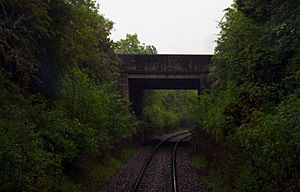Littlemore Railway Cutting facts for kids
| Site of Special Scientific Interest | |
 |
|
| Area of Search | Oxfordshire |
|---|---|
| Interest | Geological |
| Area | 0.5 hectares (1.2 acres) |
| Notification | 1986 |
| Location map | Magic Map |
Littlemore Railway Cutting is a special place near Oxford, England. It's called a Site of Special Scientific Interest (SSSI) because of its amazing rocks and fossils. This small area, about 0.5-hectare (1.2-acre) (which is like a small sports field), is important for understanding Earth's history. It was officially recognized as an SSSI in 1986.
Contents
What is a Railway Cutting?
A railway cutting is a place where engineers dug away the ground to make a flat path for train tracks. When they dug through hills or raised land, they cut into the Earth. This digging exposes layers of rock that were once hidden underground. At Littlemore, this cutting shows us rocks that are millions of years old.
A Window to the Jurassic Period
The rocks you can see at Littlemore Railway Cutting are made of limestone and clay. These rocks were formed during the Jurassic Period, about 160 million years ago. This time is known as the mid-Oxfordian stage of the Late Jurassic. Imagine a time when dinosaurs roamed the Earth! The rocks here tell us about what the Oxford area was like back then.
How the Rocks Formed
The limestone and clay found here are part of something called the Stanford Formation. This is a specific group of rock layers. Scientists believe that the clay in this cutting was laid down in a special way. It seems to have settled in a channel, almost like a river or a deep ditch. This channel was located between huge coral reefs that covered the Oxford area during the Jurassic Period.
Ancient Coral Reefs
It's hard to imagine, but 160 million years ago, the area where Oxford now stands was covered by a warm, shallow sea. This sea was home to many living things, including corals. These corals grew into large reefs, much like the ones we see in tropical oceans today. The clay at Littlemore helps scientists understand how these ancient reefs grew and how the sea floor changed over time.

